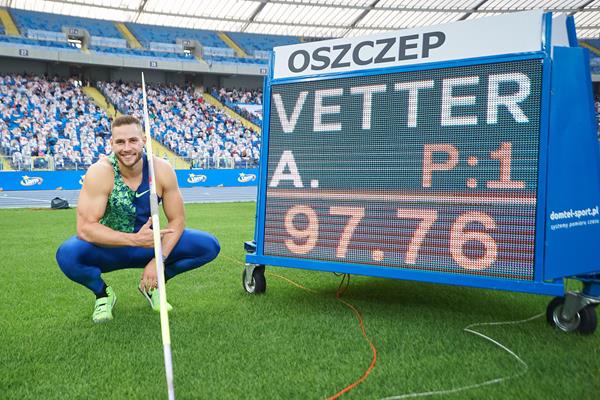Another week, another world record was seriously threatened.
With the likes of Karsten Warholm, Mondo Duplantis and Ryan Crouser having crept closer to the top of the world all-time lists in their respective events over the past few weeks, at yesterday’s World Athletics Continental Tour Gold meeting in Silesia, it was Johannes Vetter’s turn to take a crack at breaking a world record.
The German javelin thrower hadn’t necessarily targeted Jan Zelezny’s long-standing mark of 98.48m, set back in 1996, but Vetter has been in terrific form all season. The 2017 world champion had thrown beyond 90 metres at the Continental Tour meetings in Turku (91.49m) and Chorzow (90.86m) and headed to Poland last weekend with a string of six victories.
His two opening throws at the Skolimowska Memorial – 83.77m and 86.41m – hadn’t really hinted that a bigger throw was in the offing, but then he unleashed his monster effort in the third round.
As is his trademark, and such is the force with which he throws, Vetter fell to the ground upon release of his javelin. But there was also a glint in his eye; the look of an athlete who realises that they may have done something special.
Still roaring, Vetter stood up quickly and watched as his javelin sailed out across the Silesian Stadium, seemingly defying gravity. After what felt like an age – in javelin-throwing terms, at least – the implement finally landed at the other end of the infield, way beyond the 90-metre line and almost within the shot put sector at the opposite end of the green.
Moments later, the measurement appeared: 97.76m. The second-best throw in history and just 72 centimetres – about a quarter the length of an average javelin – shy of Zelezny’s world record.
Vetter, tearful and jubilant, managed to regain his composure and followed it with a 94.84m effort – the second-best throw of his career – and rounded out his series with efforts of 89.95m and 87.28m.
“In javelin throwing, small things matter, especially with the technique,” he said afterwards. “Small changes can make big differences. My grandfather was born here in 1941, so it’s a bit like coming home for me.
“I don’t really remember the throw,” he added. “You’ve got so much adrenaline in your body, I only remember celebrating afterwards.”
After then watching back a clip of the throw, Vetter offered further insights. “It was really close to perfection,” he said. “It was a good throw, yes, but it still wasn’t a world record, so I have to wait a bit more. In an open field with a good backwind, I think that throw would have been 100 metres, but I’m really happy.”

News of Vetter’s throw didn’t take long to reach Zelezny.
“I got a message first, I didn’t watch it live,” he said. “And when I heard the result, I thought ‘Okay, it is still there’.
“It was always clear that the record will go away some day. It’s already been 24 years so maybe the time has come. Johannes belongs to the group of athletes who I always thought could break it. He’s fast, he’s strong, he’s powerful.”
It’s worth noting that the track in Jena where Zelezny set the world record is a far more open facility that would have benefitted more from strong winds. That’s also true of most of the other big throws at the top of the world all-time list. Vetter’s effort in Silesia is the best ever throw achieved inside a full-sized stadium by quite some margin. The next best is Zelezny’s 92.80m from the 2001 World Championships in Edmonton.
“Ten days ago I threw over 90 metres twice in a competition in a stadium,” said the 27-year-old. “Today I did that again. I’m really close to the world record. I’m still quite young and have some more years to go. I hope that one day I will break it.”
Although 2020 has been far from a normal season, several athletes have been in record-breaking shape.
At last month’s Wanda Diamond League meeting in Monaco, Uganda’s Joshua Cheptegei broke Kenenisa Bekele’s long-standing world record for 5000m, running 12:35.36. Just last week at the Wanda Diamond League meeting in Brussels, Sifan Hassan and Mo Farah set world one-hour records on the track. The next morning in Prague, Peres Jepchirchir of Kenya broke the women-only world record for the half marathon, clocking 1:05:34.
With Warholm, Duplantis and Crouser all in peak form, the race is now on to become the next athlete to break a world record.
Warholm has had a short but impressive outdoor campaign. After clocking a world best over 300m hurdles in Oslo, he went on to win the 400m hurdles in Monaco in 47.10 and then went even faster in Stockholm, running 46.87 – the second-fastest time in history – despite clattering the final barrier. For good measure, he went on to win the 400m flat later that afternoon in 45.05.
Warholm will race at tomorrow’s Continental Tour Gold meeting in Ostrava, where he will once again target Kevin Young’s 46.78 world record from the 1992 Olympic Games in Barcelona.
Duplantis broke the world pole vault record twice during the indoor season earlier this year and then carried that momentum through to the outdoor season. Undefeated in all 13 of his competitions in 2020, the young Swede scaled 6.07m with room to spare in Lausanne before having an attempt at 6.15m – what would have been the best ever outdoor vault in history – but the lack of light made vaulting too difficult and so he called it a night.
The 20-year-old’s next competition will be at the Continental Tour Silver meeting in Berlin on Sunday (13) when he will be up against the two men with whom he shared a podium at last year’s World Championships: gold medallist Sam Kendricks and bronze medallist Piotr Lisek. After that, he intends on competing at the Wanda Diamond League meetings in Rome and Doha.
Crouser – like Vetter, Warholm and Duplantis – is also undefeated this year. The Olympic shot put champion set a PB of 22.91m in July to move to equal third on the world all-time list. He followed it with 22.56m and 22.72m victories in Des Moines in late August and last weekend won in Silesia with a Polish all-comers’ record of 22.70m.
Already the most prolific 22-metre thrower in history, the 27-year-old will next compete at the Continental Tour Gold meetings in Ostrava on Tuesday and Zagreb next week. The meeting records of 22.27m (Ostrava) and 22.28m (Zagreb) seem to be a realistic target, while the world record of 23.12m looks to be living on borrowed time.
Vetter, meanwhile, will be in action on Tuesday (8) at the Continental Tour Bronze meeting in Dessau, a more open venue that has previously played host to several 90-metre performances, and then at the ISTAF meeting in Berlin on Sunday. The MDR website will have a live stream of Dessau.
Keen to stress the nuances of the event, Vetter himself said in Silesia: “Last week I threw 84 metres, this week I threw 97. Those little things make a big difference.” But provided he finds the right elements to tweak before Tuesday’s competition, he could once again challenge the world record.
The race is on.
Stats
Vetter’s progression
2009: 58.10m (700g)
2010: 68.73m (700g), 51.77m
2011: 71.60m
2012: 61.39m
2013: 76.58m
2014: 79.75m
2015: 85.40m
2016: 89.57m
2017: 94.44m
2018: 92.70m
2019: 90.03m
2020: 97.76m
World javelin all-time list
98.48m Jan Zelezny (CZE) Jena 1996
97.76m Johannes Vetter (GER) Silesia 2020
93.90m Thomas Rohler (GER) Doha 2017
93.09m Aki Parviainen (FIN) Kuortane 1999
92.72m Julius Yego (KEN) Beijing 2015
92.61m Sergey Makarov (RUS) Sheffield 2002
92.60m Raymond Hecht (GER) Oslo 1995
92.06m Andreas Hofmann (GER) Offenburg 2018
91.69m Konstantinos Gatsioudis (GER) Kuortane 2000
91.59m Andreas Thorkildsen (NOR) Oslo 2006
Most prolific 90-metre throwers
53 Jan Zelezny
16 Johannes Vetter
9 Thomas Rohler
8 Andreas Thorkildsen
8 Aki Parviainen
6 Sergey Makarov
6 Raymond Hecht
6 Tero Pitkamaki
5 Andreas Hofmann
3 Vadims Vasilevskis
3 Konstantinos Gatsioudis
(including ancillary marks)





